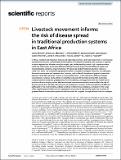| dc.description.abstract | In Africa, livestock are important to local and national economies, but their productivity is constrained by infectious diseases. Comprehensive information on livestock movements and contacts is required to devise appropriate disease control strategies; yet, understanding contact risk in systems where herds mix extensively, and where different pathogens can be transmitted at different spatial and temporal scales, remains a major challenge. We deployed Global Positioning System collars on cattle in 52 herds in a traditional agropastoral system in western Serengeti, Tanzania, to understand fine-scale movements and between-herd contacts, and to identify locations of greatest interaction between herds. We examined contact across spatiotemporal scales relevant to different disease transmission scenarios. Daily cattle movements increased with herd size and rainfall. Generally, contact between herds was greatest away from households, during periods with low rainfall and in locations close to dipping points. We demonstrate how movements and contacts affect the risk of disease spread. For example, transmission risk is relatively sensitive to the survival time of different pathogens in the environment, and less sensitive to transmission distance, at least over the range of the spatiotemporal definitions of contacts that we explored. We identify times and locations of greatest disease transmission potential and that could be targeted through tailored control strategies. | en_US |

